Better solution (Without swizzling anything or using any Private API :D )
As explained below, adding new UITapGestureRecognizers to the textview does not have the expected results, handler methods are never called. That is because the UITextView has some tap gesture recognizer setup already and I think their delegate does not allow my gesture recognizer to work properly and changing their delegate could lead to even worse results, I believe.
Luckily the UITextView has the gesture recognizer I want already setup, the problem is that it changes according to the state of the view (i.e.: set of gesture recognizers are different when inputing Japanese than when inputing English and also when not being in editing mode).
I solved this by overriding these in a subclass of UITextView:
- (void)addGestureRecognizer:(UIGestureRecognizer *)gestureRecognizer
{
[super addGestureRecognizer:gestureRecognizer];
// Check the new gesture recognizer is the same kind as the one we want to implement
// Note:
// This works because `UITextTapRecognizer` is a subclass of `UITapGestureRecognizer`
// and the text view has some `UITextTapRecognizer` added :)
if ([gestureRecognizer isKindOfClass:[UITapGestureRecognizer class]]) {
UITapGestureRecognizer *tgr = (UITapGestureRecognizer *)gestureRecognizer;
if ([tgr numberOfTapsRequired] == 1 &&
[tgr numberOfTouchesRequired] == 1) {
// If found then add self to its targets/actions
[tgr addTarget:self action:@selector(_handleOneFingerTap:)];
}
}
}
- (void)removeGestureRecognizer:(UIGestureRecognizer *)gestureRecognizer
{
// Check the new gesture recognizer is the same kind as the one we want to implement
// Read above note
if ([gestureRecognizer isKindOfClass:[UITapGestureRecognizer class]]) {
UITapGestureRecognizer *tgr = (UITapGestureRecognizer *)gestureRecognizer;
if ([tgr numberOfTapsRequired] == 1 &&
[tgr numberOfTouchesRequired] == 1) {
// If found then remove self from its targets/actions
[tgr removeTarget:self action:@selector(_handleOneFingerTap:)];
}
}
[super removeGestureRecognizer:gestureRecognizer];
}
- (void)_handleOneFingerTap:(UITapGestureRecognizer *)tgr
{
NSDictionary *userInfo = [NSDictionary dictionaryWithObject:tgr forKey:@"UITapGestureRecognizer"];
[[NSNotificationCenter defaultCenter] postNotificationName:@"TextViewOneFingerTapNotification" object:self userInfo:userInfo];
// Or I could have handled the action here directly ...
}
By doing this way, no matter when the textview changes its gesture recognizers, we will always catch the tap gesture recognizer we want → Hence, our handler method will be called accordingly :)
Conclusion:
If you want to add a gesture recognizers to the UITextView, you have to check the text view does not have it already.
- If it does not have it, just do the regular way. (Create your gesture recognizer, set it up, and add it to the text view) and you are done!.
- If it does have it, then you probably need to do something similar as above.
Old Answer
I came up with this answer by swizzling a private method because previous answers have cons and they don't work as expected. Here, rather than modifying the tapping behavior of the UITextView, I just intercept the called method and then call the original method.
Further Explanation
UITextView has a bunch of specialized UIGestureRecognizers, each of these has a target and a action but their target is not the UITextView itself, it's an object of the forward class UITextInteractionAssistant. (This assistant is a @package ivar of UITextView but is forward definition is in the public header: UITextField.h).
UITextTapRecognizer recognizes taps and calls oneFingerTap: on the UITextInteractionAssistant so we want to intercept that call :)
#import <objc/runtime.h>
// Prototype and declaration of method that is going be swizzled
// When called: self and sender are supposed to be UITextInteractionAssistant and UITextTapRecognizer objects respectively
void proxy_oneFingerTap(id self, SEL _cmd, id sender);
void proxy_oneFingerTap(id self, SEL _cmd, id sender){
[[NSNotificationCenter defaultCenter] postNotificationName:@"TextViewOneFinderTap" object:self userInfo:nil];
if ([self respondsToSelector:@selector(proxy_oneFingerTap:)]) {
[self performSelector:@selector(proxy_oneFingerTap:) withObject:sender];
}
}
...
// subclass of UITextView
// Add above method and swizzle it with.
- (void)doTrickForCatchingTaps
{
Class class = [UITextInteractionAssistant class]; // or below line to avoid ugly warnings
//Class class = NSClassFromString(@"UITextInteractionAssistant");
SEL new_selector = @selector(proxy_oneFingerTap:);
SEL orig_selector = @selector(oneFingerTap:);
// Add method dynamically because UITextInteractionAssistant is a private class
BOOL success = class_addMethod(class, new_selector, (IMP)proxy_oneFingerTap, "v@:@");
if (success) {
Method originalMethod = class_getInstanceMethod(class, orig_selector);
Method newMethod = class_getInstanceMethod(class, new_selector);
if ((originalMethod != nil) && (newMethod != nil)){
method_exchangeImplementations(originalMethod, newMethod); // Method swizzle
}
}
}
//... And in the UIViewController, let's say
[textView doTrickForCatchingTaps];
[[NSNotificationCenter defaultCenter] addObserver:self selector:@selector(textViewWasTapped:) name:@"TextViewOneFinderTap" object:nil];
- (void)textViewWasTapped:(NSNotification *)noti{
NSLog(@"%@", NSStringFromSelector:@selector(_cmd));
}
